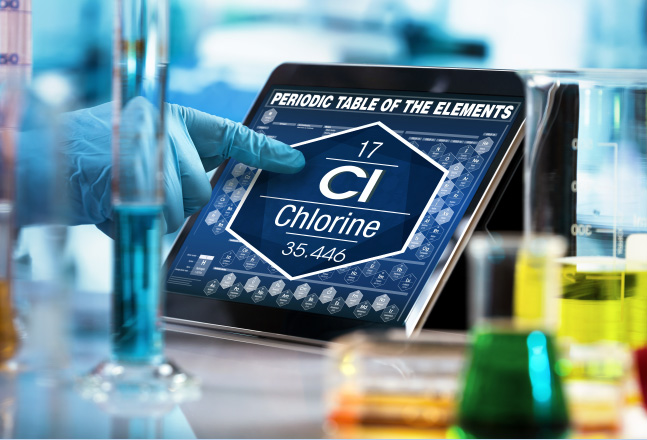Chlorine is a naturally occurring element; symbol Cl, atomic number 17 on the periodic table. 
It is a very dangerous toxin that has many uses, from disinfecting to bleaching. Even in small quantities, liquid and
gas forms can be poisonous. In its gas form, chlorine is a pale green color and has a smelly odor and makes your breathing labored. ln its solid form, it’s more of a yellow green color.
Chlorine has long been used to disinfect our water because it controls the growth of bacteria such as E-coli and Giardia. Research has shown that long-term exposure to chlorine leads the production of free radicals within the body. Free radicals are carcinogenic, and cause tremendous damage to our cells.
Children exposed to large amounts of chlorine could potentially suffer asthmatic attacks. In one research study,
rats exposed to chlorine and chloramines developed tumors in their kidneys and intestines.
According to the U.S. Council of Environmental Quality: “Cancer risk among people exposed to chlorinated
water is 93% higher
When chlorine is added to our water, it combines with other natural compounds to form Trihalomethanes
(chlorination byproducts), or THM’s. These chlorinated byproducts trigger the production of
free radicals in the body, causing cellular damage, and are highly carcinogenic.
According to the Environmental Defense Fund: “Although concentrations of these
carcinogens (THM’s) are low, it is precisely these low levels that cancer scientists believe are
responsible for the majority of human cancers in the United States.
Simply stated, chlorine is a pesticide, as defined by the U.S. EPA, whose sole purpose is to kill living organisms.
Breast cancer,which now affects one in every eight women in North America, has recently been linked to the accumulation of chlorine compounds in the breast tissue.
A study carried out in Hartford Connecticut, the first of its kind in North America, found that, “women with breast cancer have 50% to 6O% higher levels of organochlorines {chlorination byproducts} in their breast tissue than women without breast cancer.”
The steam we inhale while showering can contain up to 50
times the level of chemicals than tap water due to the fact that chlorine and most other contaminants vaporize much
faster and at a lower temperature than water.
If you’d like to stop drinking and bathing in water with chlorine and THM’s, the best step you can take is to contact
us for more information about a water filtration system for your home.
